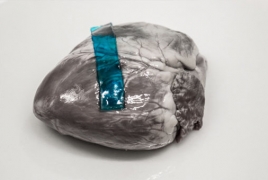Researchers make slug slime-inspired biomedical adhesive July 28, 2017 - 11:33 AMT PanARMENIAN.Net - A new class of tissue glues can seal a punctured pig heart, new research says. Called Tough Adhesives, these new glues could one day help close up wounds in the hard-to-reach, slimy depths of our bodies. That’s still a ways away, however. So far, they’ve mainly been tested on the blood-covered skin and beating heart of a pig, The Verge said. The research is part of a bigger push to develop tissue adhesives that can safely and effectively seal up internal cuts and holes left by trauma, surgery, or birth defects. Right now, a patient’s options are pretty limited to sutures and staples, which can be challenging to use in hard-to-reach, internal places. Medical-grade super glue can only work on dry surfaces like skin. It also dries too stiffly, and is too toxic to use inside the body. The other tissue adhesives on the market just don’t stick well enough, experts say. Developed by a team of scientists at Harvard University, these new Tough Adhesives can stay sticky even in soggy environments, according to a new study published in the journal Science. They also don’t appear to be toxic to human cells. That’s key for a glue designed to be used inside the human body. The researchers used their Tough Adhesives to successfully close up a hole in a beating pig heart (the pig was dead, and the heart was artificially made to beat with a machine). It also stopped a slimy rat liver from bleeding, and it stuck to pig skin and a real live pig heart that had been dribbled with blood. “That’s the fun part,” says the study’s lead author, Harvard postdoctoral fellow Jianyu Li. “It’s an elegant piece of work,” says Mark Grinstaff, a chemistry professor at Boston University and founder of tissue adhesives company Hyperbranch, who was not involved in the research. The fact that the glue worked even on the rat liver was noteworthy, he says: “The liver is really hard to get materials to stick to because it has a really slimy surface.” Jeff Karp, a researcher at Brigham and Women’s Hospital and founder of another tissue adhesives company, Gecko Biomedical, agrees. He cautions, however, that translating a new tissue glue to the clinic isn’t easy. Many scientists trying to develop better adhesives take inspiration from naturally sticky creatures, like mussels that glue themselves to rocks. The Harvard team, working in bioengineer David Mooney’s lab, looked to the Dusky Arion, a two-inch-long slug that oozes a sticky, defensive mucus. This mucus has two key components: an adhesive that anchors to surfaces, mixed into a kind of flexible gel. The researchers didn’t actually use any of the molecules in the slug mucus, lead author Li clarifies. Instead, they used a similar and intuitive design strategy: mixing a sticky ingredient with something that can stretch and withstand the stresses exerted by a moving body. The sticky ingredients were ones that already exist, like the gelatin you’d find in your jello, connective tissue extracted from a rat tail, a compound found in shrimp shells, and two synthetic molecules. (The shrimp shell molecule, they found, was among the stickiest.) For the stretchable, shock-absorbing material, the researchers used something called a hydrogel, which is basically a chemical soup mostly made out of water with a drizzle of a molecule found in algae. Layering these two components created several different versions of these Tough Adhesives. They dried in minutes even on bloody surfaces, and could withstand the forces from thousands of heart contractions. “It’s very promising technology,” Karp says. The challenge, he adds, will be translating it to the clinic. One hurdle these new glues will have to overcome is manufacturing, he says. Actually taking a product to market requires making it on a large scale, and making sure it doesn’t go bad when it’s sitting on a shelf, waiting to be used. “Manufacturing has been a killer for a lot of these technologies,” he says. Another barrier can be convincing clinicians to actually use the new glues that may be difficult to apply and are different from what they’re used to. But there’s a huge unmet need for this kind of technology, and Karp says this is a promising approach. Photo: Jianyu Li, Adam Celiz, David Mooney Authorities said a total of 192 Azerbaijani troops were killed and 511 were wounded during Azerbaijan’s offensive. In 2023, the Azerbaijani government will increase the country’s defense budget by more than 1.1 billion manats ($650 million). The bill, published on Monday, is designed to "eliminate the shortcomings of an unreasonably broad interpretation of the key concept of "compatriot". The earthquake caused a temporary blackout, damaged many buildings and closed a number of rural roads. Partner news |